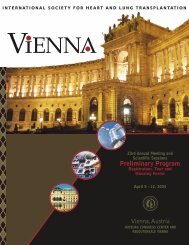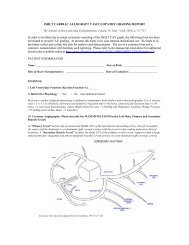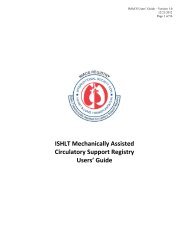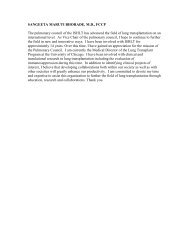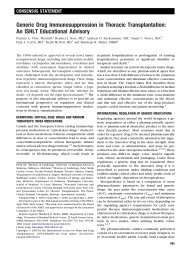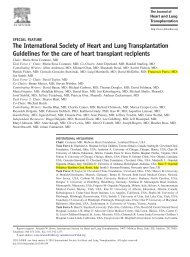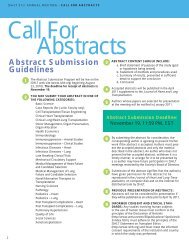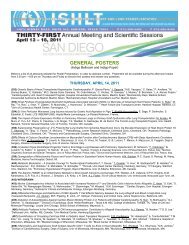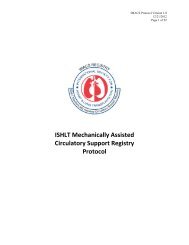Task Force 4: Inpatient Management of Patients with MCSD - The ...
Task Force 4: Inpatient Management of Patients with MCSD - The ...
Task Force 4: Inpatient Management of Patients with MCSD - The ...
Create successful ePaper yourself
Turn your PDF publications into a flip-book with our unique Google optimized e-Paper software.
Infectious Issues<br />
<strong>The</strong> classification <strong>of</strong>, investigations for, and definitions related to infection in<br />
patients <strong>with</strong> MCS were the subject <strong>of</strong> a detailed working formulation published from the<br />
Infectious Disease Council <strong>of</strong> the International Society <strong>of</strong> Heart and Lung<br />
Transplantation in 2011. 87 A brief summary <strong>of</strong> their findings will be presented here as a<br />
reference.<br />
Infections in the setting <strong>of</strong> MCS can be classified as <strong>MCSD</strong>-specific, <strong>MCSD</strong>related,<br />
or non-<strong>MCSD</strong> infections. For <strong>MCSD</strong>-specific infections, the source can be<br />
related to the pump and/or cannula, the pump pocket, or the driveline. In contrast,<br />
<strong>MCSD</strong>-related infections consist <strong>of</strong> infective endocarditis, blood stream infections, and<br />
mediastinitis. Non-<strong>MCSD</strong> infections such as urinary tract infections will not be<br />
addressed in these guidelines. When approaching a patient on MCS <strong>with</strong> a suspected<br />
infection, the initial work-up should include a complete blood count, chest radiography,<br />
and blood cultures. For those <strong>with</strong> purulent drainage from a surgical site, cannula, or<br />
driveline, samples for Gram stain, KOH, and routine bacterial and fungal cultures should<br />
be obtained.<br />
Recommendations for MCS <strong>Patients</strong> <strong>with</strong> a Suspected Infection:<br />
Class I:<br />
1. In all patients, a complete blood count, chest radiography, and blood cultures is<br />
recommended.<br />
Level <strong>of</strong> Evidence: A.<br />
2. At least three sets <strong>of</strong> blood cultures over 24 hours should be drawn, <strong>with</strong> at least one<br />
from any indwelling central venous catheters.<br />
Level <strong>of</strong> Evidence: A.<br />
3. For those <strong>with</strong> a suspected cannula or driveline infection, obtaining a sample for<br />
Gram stain, KOH, and routine bacterial and fungal cultures is recommended.<br />
Level <strong>of</strong> Evidence: A.<br />
4. When clinically indicated, aspirate from other potential sources as dictated by<br />
presenting symptoms and examination is recommended.<br />
Level <strong>of</strong> Evidence: A.<br />
31





